History
The first mention of this book dates from Pope Sixtus V. In order to introduce a greater variety in the selection of lessons, he ordered the compilation of an Octavarium to comprise the lessons proper to each day of the octaves. The plan was not executed during his pontificate (1585–90).
When the question of correcting the Breviary was raised anew under Clement VIII (1592–1605), the projected Octavarium was again spoken of. The consultors, the most distinguished of whom was Baronius, were in favour of the suggested compilation. Gavanti, another consultor, undertook the work, but his book did not appear until 1628.
Its descriptive title is Octavarium Romanum, Lectiones II et III Nocturni complectens, recitandas infra octavas Festorum, præsertim patronorum locorum et titularium Ecclesiarum quæ cum octavis celebrari debent, juxta rubricas Breviarii Romani, a Sacra Rituum Congregatione ad usum totius orbis ecclesiarum approbatum (Antwerp, 1628). In addition to the letter of approbation, the Papal Brief of Urban VIII and the dedication, the book includes a few pages on the origin, cause and rites of octaves.
The body of the work consists of a collection of readings, or lessons, for the feasts of the Holy Trinity, the Transfiguration, the Holy Cross, several feasts of Our Lady (Conception, Purification, Visitation, Our Lady of the Snows), the feasts of St. Michael, the Apostles, Saints Mary Magdalene, Martha, John, Athanasius, Monica, Nereus and Achilleus, the Seven Brothers, Apollinarius, the feast of the Beheading of St. John the Baptist, of Saints Gregory Thaumaturgus, Basil, Francis, Clement etc. Then follow the varied and well-selected lessons for the commons, drawn from the writings of the Church Fathers.
Numerous editions have appeared since then, with occasional variations. One is by Pustet (Ratisbon, 1883). The reading of the Octavarium is not obligatory, unlike the Breviary.
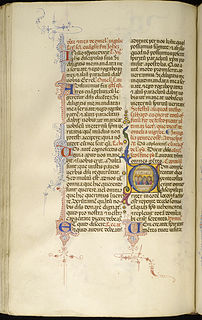
The Roman Breviary is the liturgical book of the Latin liturgical rites of the Catholic Church containing the public or canonical prayers, hymns, the Psalms, readings, and notations for everyday use, especially by bishops, priests, and deacons in the Divine Office.
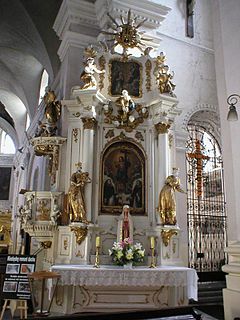
The Feast of the Holy Name of Jesus is a feast of the liturgical year celebrated by Christians on varying dates.

A missal is a liturgical book containing instructions and texts necessary for the celebration of Mass throughout the liturgical year. Versions differ across liturgical tradition, period, and purpose, with some missals intended to enable a priest to celebrate Mass publicly and others for private and lay use. The texts of the most common Eucharistic liturgy in the world, the Catholic Church's Mass of Paul VI of the Roman Rite, are contained in the 1970 edition of the Roman Missal. Missals have also been published for earlier forms of the Roman Rite and other Latin liturgical rites. Other liturgical books typically contain the Eucharistic liturgies of other ritual traditions, but missals exist for the Byzantine Rites, Eastern Orthodox Western Rites, and Anglican liturgies.
The Roman Ritual is one of the official liturgical books of the Roman Rite of the Catholic Church. It contains all of the services which may be performed by a priest or deacon which are not contained within either the Missale Romanum, the Pontificale Romanum or the Caeremoniale Episcoporum. The book also contains some of the rites which are contained in only one of these books for convenience.

The Liturgy of the Hours or Divine Office or Opus Dei are the canonical hours, often also referred to as the breviary, of the Latin Church. The Liturgy of the Hours forms the official set of prayers "marking the hours of each day and sanctifying the day with prayer." The term "Liturgy of the Hours" has been retroactively applied to the practices of saying the canonical hours in both the Christian East and West –particularly within the Latin liturgical rites – prior to the Second Vatican Council, and is the official term for the canonical hours promulgated for usage by the Latin Church in 1971. Before 1971, the official form for the Latin Church was the Breviarium Romanum, first published in 1568 with major editions through 1962.
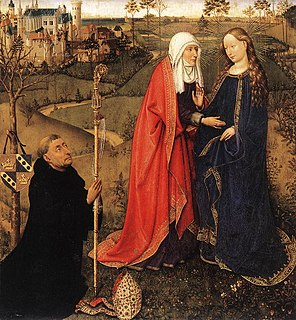
In Christianity, the Visitation is the visit of Mary, who was pregnant with Jesus, to Elizabeth, who was pregnant with John the Baptist, in the Gospel of Luke, Luke 1:39–56.
In the Latin liturgical rites of the Catholic Church, a commemoration is the recital, within the Liturgy of the Hours or the Mass of one celebration, of part of another celebration that is generally of lower rank and impeded because of a coincidence of date.

An Antiphonary is one of the liturgical books intended for use in choro, and originally characterized, as its name implies, by the assignment to it principally of the antiphons used in various parts of the Roman liturgy.
A Catholic order liturgical rite is a variant of a Catholic liturgical rite distinct from the typical ones, such as the Roman Rite, but instead specific to a certain Catholic religious order.

The Rite of the Holy Sepulchre, commonly called the Carmelite Rite, is the liturgical rite that was used by the Canons Regular of the Holy Sepulchre, Hospitallers, Templars, Carmelites and the other orders founded within the Latin Patriarchate of Jerusalem.
A triduum is a religious observance lasting three days.
The General Roman Calendar is the liturgical calendar that indicates the dates of celebrations of saints and mysteries of the Lord in the Roman Rite of the Catholic Church, wherever this liturgical rite is in use. These celebrations are a fixed annual date; or occur on a particular day of the week ; or relate to the date of Easter. National and diocesan calendars, including that of the diocese of Rome itself as well as the calendars of religious institutes and even of continents, add other saints and mysteries or transfer the celebration of a particular saint or mystery from the date assigned in the General Calendar to another date.
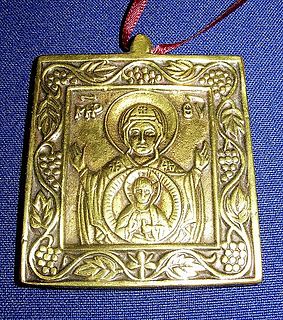
The Solemnity of Mary, the Holy Mother of God is a feast day of the Blessed Virgin Mary under the aspect of her motherhood of Jesus Christ, whom she had circumcised on the eighth day after his birth according to Levitical Law. Christians see him as the Lord and Son of God. It is celebrated by the Roman Rite of the Catholic Church on 1 January, the Octave (8th) day of Christmas. This solemnity is a Holy Day of Obligation in areas that have not abrogated it.
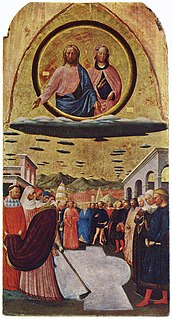
The Dedication of the Basilica of St Mary Major is a feast day in the General Roman Calendar, optionally celebrated annually on 5 August with the rank of memorial.
The reform of the Roman Breviary by Pope Pius X was promulgated by that Pope with the apostolic constitution Divino afflatu of 1 November 1911.
The Fifth Sunday of Easter is the Sunday four weeks after the Christian celebration of Easter. In Western Christianity, this day is also known as the Fourth Sunday after Easter or Cantate Sunday. Eastern Christianity also calls this day the "Fifth Sunday," but typically using an Eastern synonym for Easter; for example, Fifth Sunday of Holy Pascha or Fifth Sunday of the Resurrection. In the Byzantine Rite, this day is also known as the Sunday of the Samaritan Woman.

The Roman Pontifical, in Latin Pontificale Romanum, is the pontifical as used by the Roman Rite of the Catholic Church. The liturgical book which contains the rites and ceremonies usually performed by bishops of the Roman Rite.
The Ranking of liturgical days in the Roman Rite is a regulation for the liturgy of the Roman Catholic church. It determines for each liturgical day which observance has priority when liturgical dates and times coincide, which texts are used for the celebration of the Holy Mass and the Liturgy of the hours and which liturgical color is assigned to the day or celebration.

The Feast of the Most Holy Name of the Blessed Virgin Mary is an optional memorial celebrated in the liturgical calendar of the Catholic Church on 12 September. It has been a universal Roman Rite feast since 1684, when Pope Innocent XI included it in the General Roman Calendar to commemorate the victory at the Battle of Vienna in 1683. It was removed from the Church calendar in the liturgical reform following Vatican II but restored by Pope John Paul II in 2002, along with the Feast of the Holy Name of Jesus.
The Third Sunday of Easter is the day that occurs two weeks after the Christian celebration of Easter.
 Herbermann, Charles, ed. (1913). "Octavarium Romanum". Catholic Encyclopedia . New York: Robert Appleton Company.
Herbermann, Charles, ed. (1913). "Octavarium Romanum". Catholic Encyclopedia . New York: Robert Appleton Company.![]() This article incorporates text from a publication now in the public domain : Herbermann, Charles, ed. (1913). "Octavarium Romanum". Catholic Encyclopedia . New York: Robert Appleton Company.
This article incorporates text from a publication now in the public domain : Herbermann, Charles, ed. (1913). "Octavarium Romanum". Catholic Encyclopedia . New York: Robert Appleton Company.









